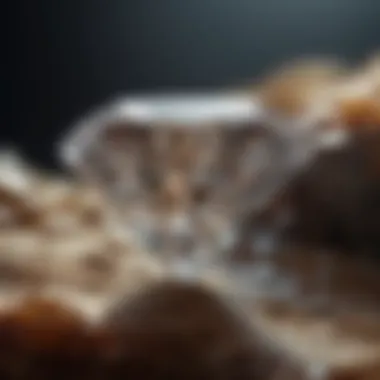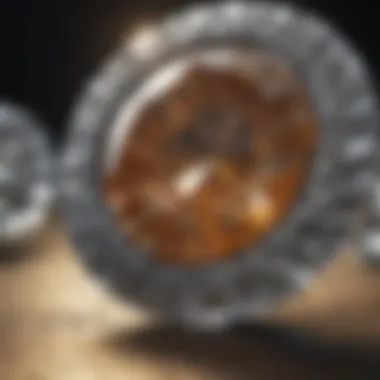Unveiling the Enchanting Elegance of Untouched Diamonds


Rock and Fossil Identification
Diamonds, in their essence, are geological marvels that captivate the human eye with their unparalleled brilliance and allure. Unlike common rocks and fossils, diamonds possess unique characteristics that set them apart in the realm of natural beauty. When identifying these treasures, observers must look beyond the surface to discern subtle distinctions that hint at the diamond's origin and purity. Examination tools such as magnifiers and refractometers play an indispensable role in the precise identification of diamonds, enabling collectors to distinguish between natural gems and synthetic imitations with acumen and precision.
Collecting Tips and Techniques
The pursuit of acquiring diamonds in their natural form demands a keen eye and a patient spirit. Aspiring collectors are advised to scout prime locations known for yielding raw diamonds, such as volcanic pipes and alluvial deposits. Safely extracting these precious stones requires delicate techniques to ensure their preservation and integrity. Diamond enthusiasts should exercise caution when extracting specimens, using tools like tweezers and soft brushes to avoid damaging the gems in the process.
Preservation and Display
Preserving the lustrous beauty of diamonds for posterity requires meticulous care and foresight. Techniques like encapsulating diamonds in inert gases or liquid-filled containers aid in safeguarding their vibrant hues and flawless structure. Storage methods play a pivotal role in maintaining the diamonds' pristine condition, with velvet-lined jewelry boxes or airtight containers providing optimal protection against external elements. For creative display ideas, consider showcasing diamonds in elegantly crafted jewelry settings or transparent display cases that accentuate their radiant beauty.
Geological Insights
The geological origins of diamonds offer a compelling narrative of Earth's transformative processes over millennia. Formed deep within the Earth's mantle under immense pressure and heat, diamonds emerge as enduring symbols of geological time capsules. Their historical significance spans centuries, with civilizations treasuring these gems for their rarity and symbolism. Notable discoveries in the field of diamond geology have unraveled the mysteries shrouding their formation, shedding light on the volcanic eruptions and tectonic movements that contribute to the creation of these exquisite gemstones.
Introduction
The essence of diamonds lies not just in their exquisite appearance but also in their enigmatic journey from the depths of the Earth to becoming prized gemstones. Diamonds, with their captivating allure and fascinating origins, have intrigued mankind for centuries. In this article, we will delve into the mesmerizing world of these treasures of nature, uncovering their raw form, unique characteristics, and the intricate processes that lead to their transformation into coveted gemstones. From their genesis deep within the Earth's crust to their radiant presence in various forms of adornments, the natural beauty of diamonds is a tale worth exploring in detail.
Defining Diamonds
Composition of Diamonds
The composition of diamonds plays a pivotal role in defining their remarkable properties. Comprised of carbon atoms arranged in a crystalline structure, diamonds exhibit exceptional hardness and brilliance. This chemical composition not only gives diamonds their renowned durability but also contributes to their ability to disperse light with unmatched radiance. The purity and clarity of the carbon arrangement in diamonds make them a popular choice for various applications, including jewelry and industrial uses. The composition of diamonds showcases nature's precision in crafting one of the most coveted gemstones known to humankind.
Historical Significance
Diving into the historical significance of diamonds unveils a rich tapestry of cultural, economic, and symbolic meanings attached to these precious gems. Throughout history, diamonds have symbolized luxury, purity, and eternal love, making them highly sought after and revered by royalty and commoners alike. The historical journey of diamonds spans centuries, encompassing tales of treasure, power, and romance. Understanding the historical significance of diamonds provides valuable insights into their enduring relevance and timeless allure.
Importance of Natural Diamonds
Intriguing Geological Origins


Exploring the geological origins of natural diamonds unravels a fascinating narrative of how these extraordinary gemstones are formed deep within the Earth's mantle. The intriguing geological processes involve immense pressure, heat, and specific chemical conditions that transform carbon into the mesmerizing crystals we know as diamonds. This geological journey not only highlights the rare occurrence of natural diamonds but also underscores their exceptional beauty and value. Delving into the geological origins of diamonds offers a glimpse into the transformative forces of nature that culminate in these remarkable creations.
Unique Physical Properties
The unique physical properties of diamonds set them apart as one of the most remarkable gemstones in the world. With a combination of hardness, brilliance, and unmatched thermal conductivity, diamonds exhibit properties that make them an ideal choice for various industrial and technological applications. From cutting and polishing tools to high-tech advancements in various fields, the physical characteristics of diamonds play a crucial role in their widespread utility and desirability. Appreciating the intricate physical properties of diamonds amplifies their allure and underscores their significance in diverse sectors.
Formation of Diamonds
Initially, let us delve into the crucial process of diamond formation. The genesis of diamonds holds a pivotal place in this discourse, shedding light on their ultimate allure and significance. Understanding the intricate journey from raw, uncut stones to coveted gemstones is paramount in appreciating the natural splendor of diamonds. The very formation of diamonds encompasses a myriad of elements, starting from their creation deep within the Earth's crust to the meticulous process of crystallization. The geological forces at play during formation infuse diamonds with their unique characteristics and properties, making them a subject of fascination for scientists, gemologists, and enthusiasts alike. The process of diamond formation not only showcases the marvels of nature but also highlights the resilience and rarity of these precious gems, ensuring their timeless appeal and enduring value.
Natural Processes
Underground Conditions
The subterranean realm plays a pivotal role in the formation of diamonds, with underground conditions serving as a crucial factor in this intricate process. These conditions, characterized by immense pressure and temperature levels, create the ideal environment for diamond crystallization. The depths of the Earth's crust harbor the necessary components and settings for diamonds to form, as geological forces interact over millions of years to produce these coveted gemstones. The unique combination of factors found in underground conditions provides the perfect breeding ground for diamonds, giving rise to their exquisite structures and clarity. Despite the challenges posed by working in such environments, the rewards of uncovering these natural treasures make the exploration of underground conditions a worthwhile endeavor in understanding the allure of diamonds.
Emterp Pressure and Trmeaperture
Extreme pressure and temperature stand as fundamental forces shaping the destiny of diamonds, contributing significantly to their remarkable formation. The intense pressure exerted deep within the Earth, coupled with soaring temperatures, initiate the crystallization process essential for diamond creation. This relentless environment molds diamonds into resilient structures, imbuing them with durability and brilliance. The interplay between extreme pressure and temperature not only defines the natural processes underlying diamond formation but also underscores the profound transformations occurring beneath the Earth's surface. Despite the challenges presented by such harsh conditions, diamonds emerge as shining examples of nature's artistry and endurance.
Timeline of Diamond Formation
Slow Crystal Growth
Slow crystal growth emerges as a key aspect in the timeline of diamond formation, shaping the unique character of these precious gemstones. The gradual development of crystals over vast spans of time results in the distinctive clarity and precision observed in diamonds. This leisurely growth process allows for the formation of intricate patterns and structures within the gems, enhancing their aesthetic appeal and value. Slow crystal growth not only influences the visual aspects of diamonds but also contributes to their remarkable resilience and durability, making them coveted treasures sought after for centuries.
Vlocanic Etrpieptions
Volcanic eruptions play a dramatic role in the timeline of diamond formation, scattering these precious gems across the Earth's surface and marking the culmination of their arduous journey. The explosive force of volcanic activity propels diamonds from their subterranean origins to the world above, enriching the planet's geology with their presence. The aftermath of volcanic eruptions reveals scattered diamonds waiting to be discovered, offering a glimpse into the tumultuous history of these remarkable gemstones. Despite the chaos brought by volcanic events, diamonds endure as enduring symbols of nature's power and beauty, capturing the imagination of all who behold their radiant splendor.
Characteristics of Natural Diamonds
Natural diamonds possess a unique allure that captivates the beholder with their mesmerizing beauty. The characteristics of these precious gemstones play a crucial role in their overall value and desirability. A deep understanding of the various aspects of natural diamond characteristics is essential for appreciating their rarity and significance in the world of luxury and adornment.
Visual Appearance


Crystal Structure
The crystal structure of natural diamonds is a defining feature that showcases their unrivaled beauty and durability. This intricate arrangement of atoms in a diamond lattice confers exceptional strength and brilliance to the gemstone. The symmetrical alignment of carbon atoms in a cubic crystal system gives diamonds their renowned hardness and refractive properties. This unique crystal structure not only contributes to the diamond's resilience but also enhances its optical properties, making it a sought-after choice for exquisite jewelry pieces.
Color Variations
The allure of natural diamonds is further accentuated by the mesmerizing array of color variations they exhibit. From the pure brilliance of colorless diamonds to the vibrant hues of fancy colored diamonds, each shade tells a story of the gem's formation deep within the Earth. The presence of trace elements during the diamond's growth process imparts distinct hues, ranging from pink and blue to yellow and red. These color variations add a touch of rarity and individuality to each diamond, making them unique works of art in the world of gemstones.
Inclusions and Imperfections
Impact on Clarity
The presence of inclusions and imperfections in natural diamonds can have a significant impact on their clarity and overall appearance. While some inclusions may lend a diamond its distinctive character, excessive flaws can diminish its brilliance and value. Understanding the nature and extent of these imperfections is crucial for evaluating a diamond's quality and determining its suitability for different types of jewelry settings. Balancing clarity considerations with other factors is essential to appreciate the true beauty of a diamond.
Identification and Authentication
Identification and authentication methods play a vital role in certifying the authenticity and quality of natural diamonds. Through advanced techniques such as laser inscription and spectroscopy, gemologists can verify a diamond's origin and characteristics with precision. These identification processes ensure transparency and trust within the diamond industry, safeguarding consumers from counterfeit practices and ensuring the integrity of the gem trade. Emphasizing the importance of reliable authentication underscores the value of natural diamonds as genuine, ethically sourced treasures.
Extraction and Mining Processes
In the comprehensive exploration of diamonds' natural beauty within this article, the topic of Extraction and Mining Processes holds significant importance. These processes are crucial in unearthing these precious gems from the depths of the Earth's crust, paving the way for their transformation into exquisite adornments that captivate the human eye. The Extraction and Mining Processes section sheds light on the intricate mechanisms involved in obtaining diamonds, from the careful extraction to the subsequent refinement. It delves into the challenges, innovations, and ethical considerations that underpin the mining of these coveted gemstones, highlighting the indispensable role these processes play in the journey of diamonds from their raw state to becoming symbols of elegance and luxury.
Mining Techniques
Open-Pit Mining
Open-Pit Mining stands as a cornerstone in the domain of diamond extraction, characterized by its expansive and visible nature. This technique involves the excavation of the Earth's surface to access diamond deposits, allowing for efficient extraction on a large scale. The distinct feature of Open-Pit Mining lies in its ability to uncover gemstones from shallower depths, streamlining the extraction process and yielding significant quantities of diamonds. One of the primary advantages of Open-Pit Mining is its cost-effectiveness and suitability for extracting diamonds located close to the surface. However, it is vital to acknowledge the environmental impact of such mining practices, as they can disrupt natural habitats and ecosystems.
Underground Excavation
Underground Excavation serves as a contrasting approach to Open-Pit Mining, focusing on accessing deeper diamond reserves lying beneath the Earth's surface. This method involves tunneling below the ground to reach the concealed gemstone deposits, requiring specialized expertise and equipment for safe and efficient extraction. The key characteristic of Underground Excavation is its ability to recover diamonds from deeper layers, often housing higher quality gemstones compared to those found through Open-Pit Mining. While Underground Excavation minimizes surface disruptions, it presents challenges in terms of operational complexities and safety hazards inherent to subterranean mining environments.
Sustainable Practices
The sustainability of diamond extraction processes is paramount in the context of environmental preservation and ethical considerations. Within this article, the discussion of Sustainable Practices encompasses two key aspects that shape the ethical landscape of the diamond industry.


Environmental Impact
Examining the environmental impact of diamond mining is crucial to understanding the industry's ecological footprint and the measures undertaken to mitigate adverse effects. By scrutinizing factors such as land degradation, water usage, and wildlife disruption, we uncover the intricate balance between diamond extraction and environmental conservation. Implementing sustainable mining practices and rehabilitation efforts post-extraction are crucial steps in minimizing the industry's ecological impact.
Ethical Sourcing
Ethical Sourcing within the diamond industry underscores the significance of responsible mining practices, fair labor conditions, and conflict-free diamond origins. This ethical framework ensures that diamonds are procured through transparent supply chains, free from exploitation or human rights abuses. By prioritizing ethical sourcing, the industry fosters a culture of accountability and social responsibility, resonating with consumers seeking ethically sourced and sustainable products.
Uses and Applications
Industrial Diamond Utilization
Cutting and Polishing Tools
Within the industrial spectrum, the utilization of diamonds in cutting and polishing tools heralds a new era of precision engineering. The key characteristic of diamond-incorporated tools lies in their unparalleled hardness and durability. This unique feature grants them the capability to cut through hard materials with precision and efficiency. In the context of this article, the usage of diamonds in cutting and polishing tools underscores the meticulous craftsmanship and innovation driving the diamond industry forward. Despite their advantages, some tools may pose challenges, such as high initial costs and meticulous maintenance.
Technological Advancements
The realm of technological advancements in diamond utilization catapults the industry into realms of innovation and efficiency. Highlighting the key characteristic of technological advancements involving diamonds sheds light on the continuous pursuit of enhancing processes and product quality. These advancements play a pivotal role in streamlining production, ensuring optimal output, and pushing the boundaries of what is achievable. However, challenges, such as capital-intensive setups and specialized skill requirements, accompany these advancements, necessitating strategic planning and investment.
Gemstone Industry
Within the gemstone industry, the artistry of jewelry crafting intertwines with the allure of diamonds, creating timeless pieces of art. The skill and precision exhibited in jewelry crafting elevate diamonds to a realm of sophistication and beauty. Understanding the key characteristic of jewelry crafting brings attention to the intricate detailing and aesthetics that define exceptional diamond jewelry pieces. While advantageous in capturing the essence of elegance, challenges like evolving trends and market saturation demand continuous innovation in design and production techniques.
Symbolism and Prestige
The symbolism and prestige associated with diamonds in the context of this article delve into the profound meanings and status attributed to these precious gemstones. Highlighting the key characteristic of symbolism and prestige elucidates the cultural significance and symbolic weight carried by diamonds. The allure of possessing a diamond transcends mere material value, embodying status and heritage. However, navigating the nuances of symbolism and prestige entails a delicate balance between tradition and modern interpretations, requiring a nuanced approach to representation and storytelling.
Conclusion:
In concluding this thorough exploration of the natural beauty encapsulated within diamonds, it is imperative to acknowledge the profound allure and significance that these marvels of nature hold. Throughout this article, we have delved into the intricate details of diamond formation, their captivating visual appearances, and the meticulous processes involved in their extraction and mining. By appreciating the natural splendor of diamonds, we gain a deeper understanding of their eternal allure and the extraordinary harmony they embody between nature and luxury. This appreciation goes beyond mere aesthetics, illustrating the enduring allure of these gemstones and their timeless appeal across various domains. The journey from the Earth's crust to exquisite jewelry exemplifies the enduring elegance and prestige that diamonds encapsulate, making them symbols of enduring beauty and sophistication.
Appreciating Diamond's Natural Splendor:
Eternal Allure:
Diving into the concept of eternal allure within diamonds reveals a fascinating aspect of their enduring charm and timeless appeal. This characteristic stems from the inherent properties of diamonds, such as their exceptional durability and mesmerizing brilliance that symbolize everlasting beauty. The eternal allure of diamonds lies in their ability to withstand the test of time, making them not just precious gemstones but also markers of lasting elegance and refinement. In this article, the focus on eternal allure highlights the everlasting nature of diamonds, emphasizing their desirability and admiration as symbols of enduring love and sophistication. This aspect of diamonds serves as a testament to their unmatched durability and timelessness, elevating them to coveted status in the realm of gemstones.
Harmony of Nature and Luxury:
Exploring the harmony between nature and luxury as manifested in diamonds unveils a unique fusion of unparalleled beauty and refined craftsmanship. This aspect underscores the seamless integration of natural elements and human artistry, resulting in creations that embody both exquisite elegance and environmental harmony. The juxtaposition of nature's raw magnificence with the sophistication of luxury craftsmanship creates a dynamic interplay that elevates diamonds to more than just gemstones but works of art. In this article, the emphasis on the harmony of nature and luxury delves into the intricate balance maintained during the extraction, processing, and transformation of diamonds into ornate jewelry. This harmonious blend accentuates the symbolic significance of diamonds as representations of nature's beauty and humanity's ingenuity, bridging the gap between environmental consciousness and gracious opulence.







